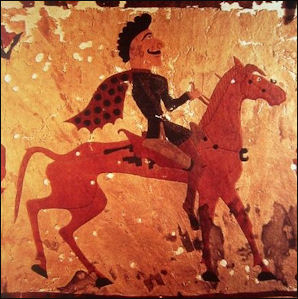HORSEMEN
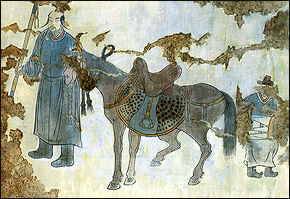
Khotan HorsemanThe Mongols, Turks, Huns, Tartars and Scythians are the best known of horsemen groups that have roamed the steppes of Central Asia and the ones that were most successful expanding beyond their native realm and impacted the worlds they touched. The Mongols created the largest empire the world have ever known. The Huns sacked Rome and forced European to build castles for protection. The Turks drove the last Christians empire out of the Middle East and came close to Islamicizing Europe.
Horseman groups originated about 2,500 years ago and continue in various forms today. Throughout their long run they have maintained many of the customs, characteristics, martial arts and methods of organization that evolved millennia ago such spending living in yurt-style tents, drinking fermented mare’s milk, fighting from horseback and creating art forms that celebrate horses and animals of the steppe.
Horse riding’s origins are uncertain and could date to at least 4,000 years ago, archaeologist Margarita Gleba of University College London told Science News. Victor Mair, a China and Central Asian expert at the University of Pennsylvania, suspects that horse riding began about 3,400 years ago in wetter regions to the north and west of the Tarim Basin in western China. [Source: Bruce Bower, Science News, May 30, 2014]
See Separate Article EARLY HORSE DOMESTICATION: BOTAI CULTURE, EVIDENCE AND DOUBTS factsanddetails.com
Websites and Resources: Mongols and Horsemen of the Steppe "The Horse, the Wheel and Language, How Bronze-Age Riders from the Eurasian Steppes shaped the Modern World", David W Anthony, 2007 archive.org/details/horsewheelandlanguage ; The Scythians - Silk Road Foundation silkroadfoundation.org ; Scythians iranicaonline.org ; Encyclopaedia Britannica article on the Huns britannica.com ; Wikipedia article on Eurasian nomads Wikipedia Wikipedia article on Mongols Wikipedia ; The Mongol Empire web.archive.org/web ; The Mongols in World History afe.easia.columbia.edu/mongols ; William of Rubruck's Account of the Mongols washington.edu/silkroad/texts ; Mongol invasion of Rus (pictures) web.archive.org/web ; Encyclopædia Britannica article britannica.com ; Mongol Archives historyonthenet.com
Ancient Mongolia and Eurasian Steppe
The home range of the early horsemen, the Eurasia steppe, is vast area of land that extends from the Carpathian mountains in Hungary to eastern Mongolia. Archeological evidence shows that people lived in Tuva and Altai regions of southern Russia, eastern Kazakhstan and western Mongolia in Paleolithic times. The Scythians roamed there from the 7th to 3rd centuries B.C., followed by the Huns in the 2nd century B.C. to A.D. 2nd century, the ancient Turks from th 6th to 12th centuries, the Uighurs in the 8th century and the Kyrgyz in the 9th century. In 1207 the region was conquered by Mongols under Genghis Khan.

Mongolian steppe
Archaeological evidence places early Stone Age human habitation in the southern Gobi between 100,000 and 200,000 years ago. By the first millennium B.C., bronze-working peoples lived in Mongolia. With the appearance of iron weapons by the third century B.C., the inhabitants of Mongolia had begun to form tribal alliances and to threaten China. The origins of more modern inhabitants are found among the forest hunters and nomadic tribes of Inner Asia. They inhabited a great arc of land extending generally from the Korean Peninsula in the east, across the northern tier of China to the Kazakh Soviet Socialist Republic and to the Pamir Mountains and Lake Balkash in the west. [Source: Library of Congress, June 1989 *]
Archaeologists working in Outer Mongolia and Inner Mongolia in China have uncovered the remains of more than 100 walled towns and cities of settled people dating back as far as the 3rd millennium B.C. and found extraordinarily beautiful artifacts such as stone altars and jade dragons. Scattered around Outer Mongolia are burial stones organized in squares and circles. Some cover slab-lined tombs and are thought to date as far back as to 2000 B.C.
Around 1500 B.C., Mongolia became colder and drier—a climate more conducive to grasslands than crops—prompting a shift from a crop-based to livestock-centered society. Cattle was raised in areas where pastures were rich. Sheep were raised in areas where the pastures were sparser.
During most of recorded history, Mongolia and the Eurasian steppe has been an area of constant ferment from which emerged numerous migrations and invasions to the southeast (into China), to the southwest (into Transoxiana — modern Uzbek Soviet Socialist Republic, Iran, and India), and to the west (across Scythia toward Europe). By the eighth century B.C., the inhabitants of much of this region evidently were nomadic Indo-European speakers, either Scythians or their kin. Also scattered throughout the area were many other tribes that were primarily Mongol in their ethnologic characteristics. *
First Horsemen
Pazyrvk HorsemanThe first domesticated horses appeared around 6000 to 5000 years ago. The first horseback riders may have been people from the Sredni Stog culture, who lived east of the Dnieper River, in what is now Ukraine, between 4200 and 3500 B.C. Evidence for this claim are scraps of bone and horn that may have been the cheek pieces of bridles. Archeologist David Anthony of Hartwick College in New York have examined horse teeth found at Sredni Stog sites, looking for signs of wear from metal or rope bits. [National Geographic Geographica, June 1989].
The first hard evidence of mounted riders dates to about 1350 B.C. Uncovering information about ancient horsemen is difficult. They left behind no written records and relatively few other groups wrote about them. For the most part they were nomads who had few possession, and never stayed in one place for long, making it difficult for archeologists — who have traditionally excavated ancient cities and settlements of settled people — to dig up artifacts connected with them.
For similar reasons it is difficult to work out how different horsemen groups interacted and how individuals within the group behaved. What little is known about group interaction has been learned mostly from the work of linguists. Most of what is known about their behavior is based on observations of modern groups or a hand full of descriptions by ancient historians..
Based on these sources, scholars believe that early nomadic horsemen lived in small groups, often organized by clan or tribe, and generally avoided forming large groups. Small groups have more mobility and flexibility to move to new pastures and water sources. Large groups are much more unwieldy and more likely to generate feuds and other internal problems. On the steppe there generally was enough land for all so the only time horsemen needed to unite was to face a common threat.
First Wheels and Wheeled Vehicles
The wheel, some scholars have theorized, was first used to make pottery and then was adapted for wagons and chariots. The potter’s wheel was invented in Mesopotamia in 4000 B.C. Some scholars have speculated that the wheel on carts were developed by placing a potters wheel on its side. Other say: first there were sleds, then rollers and finally wheels. Logs and other rollers were widely used in the ancient world to move heavy objects. It is believed that 6000-year-old megaliths that weighed many tons were moved by placing them on smooth logs and pulling them by teams of laborers.
Early wheeled vehicles were wagons and sleds with a wheel attached to each side. The wheel was most likely invented before around 3000 B.C. — the approximate age of the oldest wheel specimens — as most early wheels were probably shaped from wood, which rots, and there isn't any evidence of them today. The evidence we do have consists of impressions left behind in ancient tombs, images on pottery and ancient models of wheeled carts fashioned from pottery.◂
Evidence of wheeled vehicles appears from the mid 4th millennium B.C., near-simultaneously in Mesopotamia, the Northern Caucasus and Central Europe. The question of who invented the first wheeled vehicles is far from resolved. The earliest well-dated depiction of a wheeled vehicle — a wagon with four wheels and two axles — is on the Bronocice pot, clay pot dated to between 3500 and 3350 B.C. excavated in a Funnelbeaker culture settlement in southern Poland. Some sources say the oldest images of the wheel originate from the Mesopotamian city of Ur A bas-relief from the Sumerian city of Ur — dated to 2500 B.C. — shows four onagers (donkeylike animals) pulling a cart for a king. and were supposed to date sometime from 4000 BC. [Partly from Wikipedia]
In 2003 — at a site in the Ljubljana marshes, Slovenia, 20 kilometers southeast of Ljubljana — Slovenian scientists claimed they found the world’s oldest wheel and axle. Dated with radiocarbon method by experts in Vienna to be between 5,100 and 5,350 years old the found in the remains of a pile-dwelling settlement, the wheel has a radius of 70 centimeters and is five centimeters thick. It is made of ash and oak. Surprisingly technologically advanced, it was made of two ashen panels of the same tree. The axle, whose age could not be precisely established, is about as old as the wheel. It is 120 centimeters long and made of oak. [Source: Slovenia News]
The wheel and axle were found near a wooden canoe. Both the wheel and the axle had been scorched, probably to protect them against pests. Slovenian experts surmise that the wheel they found belonged to a single-axle cart. The aperture for the axle on the wheel is square, which means the wheel and the axle rotated together and, considering the rough ground, the cart probably had only one axle. We can only guess what the cart itself was like. The Ljubljana marshes are a perfect place for old objects to be preserved. There have been many finds uncovered in this area. Apart from the wooden wheel, axle and canoe, there have been innumerable objects found which are up to 6,500 years old.
A wheel dated to 3000 B.C., was found near Lake Van in eastern Turkey. Wheels with simialr dates have been found in germany and Switzerland. One very old wheel was a wooden disc discovered at an archeological sight near Zurich. The wheel now can be seen in the Zurich museum.
Carts, Onangers and Horses
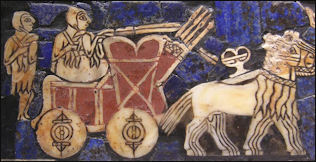
5000-year-old Mesopotamian cart in Ur Animals pulling carts preceded mounted riders by as much as 2,000 years. A bas-relief from the Sumerian city of Ur, dated to 2500 B.C., shows four onangers (donkey-like animals) pulling a cart for a king. The first animals used to pull sledges (carts without wheels) were probably oxen (bulls made more docile by castration). The first carts were probably sledges with logs rolled underneath them.
Over time onangers and donkeys — animals that often will not move even when furiously whipped — were later replaced by horses who are less stubborn, faster, and have a lower threshold for pain than a donkeys. In the second millennia B.C. horses were increasingly to pull weights on the Central Asian steppes. These horses were smaller and shaggier than modern horses, and much more difficult to control than oxen. Deep-furrowed plows also began to be utilized by farmers in the second millennia B.C. Muscular oxen proved to be much better suited for this kind of work than horses.
Herdsman at this time had learned to breed sheep, goats, and cattle, and it follows that they applied what they learned about breeding to horses. Through breeding, horses were made manageable enough to attach to carts with the mouth-fitted bit . By contrast donkeys were controlled by reins attached to nose rings and oxen were harnessed to yokes shaped around their shoulders.
See Separate Article: ONAGERS: CHARACTERISTICS, BEHAVIOR AND REPRODUCTION factsanddetails.com
First Horse-Pulled Chariots
Luis Alberto Ruiz wrote in National Geographic: The earliest chariots appeared in Mesopotamia around 3000 B.C. They were very different from the familiar horse-drawn vehicles seen in ancient Greece and Rome. Early prototypes often had four solid wheels, and their main purpose was for use in parades and funerary rites. These vehicles were not pulled by horses, but by oxen and other draft animals, or equids such as donkeys or mules. The Standard of Ur, a casket from the Sumerian city of Ur dating to around 2600 B.C., features a chariot that looks like a solid-wheeled wagon pulled by either mules or donkeys. [Source: Luis Alberto Ruiz, National Geographic, May 1, 2020]
The beginning of the second millennium B.C. was a period of rapid change for chariot building. In this period, the horse was first used as a draft animal, and wheels became increasingly spoked, and therefore much lighter. The advances in speed and mobility that resulted from these innovations led to the chariot becoming essential military equipment in the Bronze Age. (Constantinople's chariot races were all the rage in the Roman Empire.)
.jpg)
Hittite Lion-hunt relief
at AslantepeChariots may have preceded mounted riders by at least 1,000 years. Because oxen were better suited for pulling plows and heavy loads, horses were attached to lighter vehicles that evolved into chariots. Lightweight chariots, employing technology similar to that used to make racing bicycles light, could move quite fast. Ancient Egyptian chariots, pulled by a pair of horses and weighing only 17 pounds, could reach easily reach speeds of 20 miles-per-hour. A cart pulled by oxen, by contrast, rarely exceeded two miles-per-hour.
Chariots preceded mounted horses and saddles in part because the early domesticated horses were small and not strong enough to support men on their backs. The first chariots were probably used by shepherds to help them hunt wolves, leopards and bears that threatened their flocks and were alter adapted for warfare.
The important elements of a chariot were the wheels, chassis, draught pole and metal fittings. Advancement in metallurgy, woodworking, tanning and leatherworking, the uses of glues, bone and sinew all made the construction of chariots possible but the most important development of all was the improvement in physique of horse to pull such a vehicle.
Earliest Evidence of Chariots
John Noble Wilford wrote in the New York Times, “In ancient graves on the steppes of Russia and Kazakhstan, archeologists have uncovered skulls and bones of sacrificed horses and, perhaps most significantly, traces of spoked wheels. These appear to be the wheels of chariots, the earliest direct evidence for the existence of the two-wheeled high-performance vehicles that transformed the technology of transport and warfare.[Source: John Noble Wilford, New York Times, February 22, 1994]
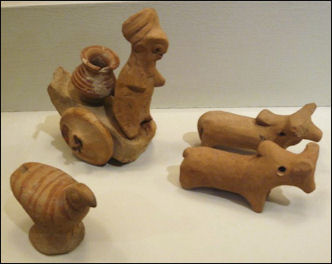
Indus Valley ox-pulled cart “The discovery sheds new light on the contributions to world history by the vigorous pastoral people who lived in the broad northern grasslands, dismissed as barbarians by their southern neighbors. From these burial customs, archeologists surmise that this culture bore a remarkable resemblance to the people who a few hundred years later called themselves Aryans and would spread their power, religion and language, with everlasting consequence, into the region of present-day Afghanistan, Pakistan and northern India. The discovery could also lead to some revision in the history of the wheel, the quintessential invention, and shake the confidence of scholars in their assumption that the chariot, like so many other cultural and mechanical innovations, had its origin among the more advanced urban societies of the ancient Middle East.
New analysis of material from the graves shows that these chariots were built more than 4,000 years ago, strengthening the case for their origin in the steppes rather than in the Middle East. If the ages of the burial sites are correct, said Dr. David W. Anthony, who directed the dating research, chariots from the steppes were at least contemporary with and perhaps even earlier than the earliest Middle East chariots. The first hint of them in the Middle East is on clay seals, dated a century or two later. The seal impressions, from Anatolia, depict a light, two-wheel vehicle pulled by two animals, carrying a single figure brandishing an ax or hammer.
"Scholarly caution tells me the matter is not resolved," said Dr. Anthony, an anthropologist at Hartwick College in Oneonta, N.Y. "But my gut feeling is, there's a good chance the chariot was invented first in the north." While praising Dr. Anthony's work, Mary Littauer, an independent archeologist and co-author of "Wheeled Vehicles and Ridden Animals in the Ancient Near East" (Brill, 1979), was not ready to concede the point. "It's still debatable," she said. "A spoked wheel is not necessarily a chariot, only a light cart on the way to becoming chariots."
Other archeologists and historians said they would not be surprised to learn that the chariot had originated in the steppes. After all, pastoralists there were probably the first to tame and ride horses; as Dr. Anthony determined in other research reported four years ago, this may have occurred at least 6,000 years ago. Then they developed wagons with solid disk wheels, and many centuries later learned to make the lighter spoked wheels, the breakthrough invention leading to the fast, maneuverable chariot. The results of Dr. Anthony's dating research was presented at a meeting of the American Anthropological Association and an interpretation of the results was published in Archaeology, the magazine of the Archeological Institute of America.
Sintashta-Petrovka Culture of the Russian and Kazakhstan Steppes
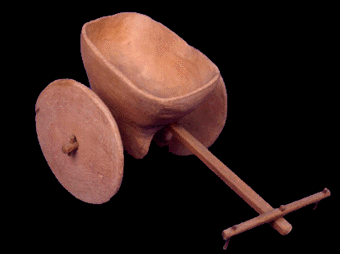
Indus Valley cart “The culture of the Russian and Kazakhstan steppes was virtually unknown until” the early 1980s, Wilford wrote in the New York Times, “when Russian archeologists began systematic excavations at several sites east of the Ural Mountains. One of the first sites explored was at a place called Sintashta, southeast of the city of Magnitogorsk. Another was Petrovka, 400 miles to the east on the Ishym River in northern Kazakhstan. [Source: John Noble Wilford, New York Times, February 22, 1994]
“Archeologists thus refer to these ancient people as the Sintashta-Petrovka culture. Their widely scattered settlements were linked culturally, as seen in the many similarities of their ceramics, metal weapons and tools, architecture and burial rituals. Find in Ancient Cemetery
At Sintashta, archeologists uncovered a large settlement of about 50 rectangular structures arranged in a circle within a timber-reinforced earthen wall. They found slag deposits from copper metallurgy, bronze weapons and gold earrings and the remains of six chariots in a cemetery of elite graves covered by earth mounds, or kurgans. Similar artifacts, and more chariots, were discovered at several other sites.
Russian scientists estimated that the culture flourished between 1700 and 1500 B.C. This inspired Dr. Stuart Piggott, a retired archeologist at Edinburgh University in Scotland and a specialist on ancient wheeled transport, to propose several years ago that if these people had developed chariots, as preliminary reports from the graves suggested, they could be the earliest developed anywhere.
But it was not until the end of the cold war that Western scholars began to learn the details of these excavations and could test Dr. Piggott's hypothesis. Enter Dr. Anthony, who had been collaborating with Russian archeologists on other research involving prehistoric cultures. He went to Dr. Nikolai B. Vinogradov, an archeologist at Chelyabinsk State Pedagogical Institute, who directed excavations of the chariot burials, and got permission to apply new radiocarbon dating techniques on those materials.
Sintashta-Petrovka Grave witha Chariot
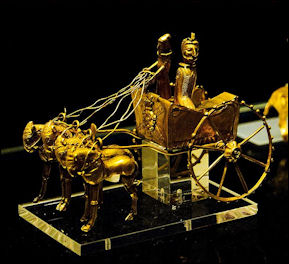
Model of a chariot
from the Oxus Treasure “In a grave pit at Krivoe Ozero, 120 miles north of Sintashta, archeologists had found an assemblage of materials typical of these burials,” Wilford wrote in the New York Times. “The heads of two ritually killed horses were deposited next to the body of a man and a chariot, much like later Aryan practices. Other grave goods included spear points, a bronze ax and a dagger, three pots and four disk-shaped cheekpieces from a horse harness. The bit used to control a horse passes through these cheekpieces, which were made of bone and antler. The rein is attached to the bit. [Source: John Noble Wilford, New York Times, February 22, 1994]
For dating the burial, Dr. Anthony took four samples of bone from the skulls of two horses in a single grave. They were analyzed at the University of Arizona at Tucson by a highly accurate type of radiocarbon dating technology using an accelerator mass spectrometer. This yielded a range of age estimates, from 2136 to 1904 B.C., with an average of 2026 — much earlier than the Russians had estimated. Similar ages were determined independently at Oxford University in England, using samples from other steppe sites.
The chariots in the graves had decayed to dust, but not without a trace. The wheels had been fitted into slots cut into the dirt floor of the burial chamber. The lower parts of each wheel left stains as they decayed. The stains preserved the shape and design of the wheels. Some parts of a chariot superstructure were also preserved in this way.
Early Chariots
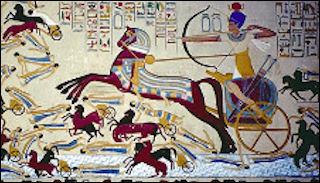
Hyksos chariot ”A chariot is usually defined as a lightweight vehicle with two spoked wheels and drawn by two horses,” Wilford wrote in the New York Times. “The earliest ones in the steppes and the Middle East probably used a form of the ox yoke around the horses' necks. Yokes adapted especially for horses, allowing them more freedom of movement, do not appear in Middle East art until the middle of the second millennium B.C. This probably represented the fully developed chariot, but the earlier versions also qualify as chariots in the eyes of nearly all scholars. [Source: John Noble Wilford, New York Times, February 22, 1994]
Sintashta-Petrovka wheels had 8 to 12 spokes. Early chariots in the Middle East, as revealed in the Anatolian seal impressions, had only four spokes. The steppe chariots were also quite narrow. The distance between the two wheels was consistently less than four feet, probably suitable for only one person. Chariots widely used in Middle East warfare in later centuries were wider, capable of carrying two or three people.
Both the difference in numbers of spokes and in width, Dr. Anthony said, suggest that the steppe chariots probably evolved locally. He said it was improbable that the technology developed independently in both places; more likely, it arose in one place and was soon introduced in the other.
"It is likely that chariot designs and perhaps uses varied from region to region, even during the initial rapid diffusion of chariot technology," he said. For example, the steppe chariot might have been developed not for warfare, but for use in ritual races meant to settle disputes or win prizes, which was an Aryan practice.
Dr. James D. Muhly, a professor of ancient history at the University of Pennsylvania, said the findings were important because they revealed a moment in the transition from wagons and carts with solid wheels to lighter vehicles with the spoke wheel, which weighed a tenth as much as the solid versions. People in Mesopotamia and on the steppes had been hitching oxen, asses and horses to these heavy wagons and carts since before 3000 B.C. Mesopotamian art as early as 2600 shows warriors being transported to battle in carts with solid wheels. Major Gain in Mobility
With the light, two-wheeled chariot, said Dr. Robert Drews, a classics professor at Vanderbilt University in Nashville, people could fully exploit the horse as a draft animal. And while an ox cart traveled only 2 miles an hour, a team of chariot horses could cover 10.
Chariot’s Military Applications

Egyptian chariot ”This led to many applications, the most flamboyant of which was the chariot as a terrifying and efficient instrument of war in the late Bronze Age,” Wilford wrote in the New York Times. From about 1700 to 1200 B.C., military strategy centered on chariotry, setting off an arms race. Rulers from Anatolia to Egypt and Crete to Mesopotamia strained palace treasuries to build more and more chariots, which were expensive. In the Bible, King Solomon is said to have paid 600 shekels of silver for each chariot; it had cost David only 50 shekels to buy a team of oxen and a threshing floor. [Source: John Noble Wilford, New York Times, February 22, 1994]
And then, as Dr. Drews pointed out in his book "The End of the Bronze Age," published last year by Princeton University Press, there was the expense of maintaining the chariot force with horse trainers and grooms, veterinarians and carpenters, charioteers to drive and warriors skilled in archery and a bureaucracy of clerks and quartermasters to keep track of all this.
Although "the general character of chariot warfare remains unexplored," Dr. Drews wrote, the vehicle was probably used as a mobile shooting platform for archers. With charioteers at the reins, a mass of chariots would race forward while archers standing behind the driver would send a rain of arrows into the enemy ranks. It is thought that the Hittites introduced a third man, someone to hold a shield.
One of the culminating battles of chariotry came early in the 13th century B.C., when armies of the Hittites and Egyptians clashed on the plains of northern Syria at Kadesh. Muwatallis II, the Hittite king, deployed a force of 3,500 chariots, and Ramses II is supposed to have countered in kind, but the battle seems to have ended in a stalemate. By the end of that century, as armies learned to blunt the attacks with swarming infantry and later cavalry, the age of the chariot as a weapon drew to a close. The high-speed vehicle was reduced to roles in sport and regal parades.
Chariots and Indo-European Language
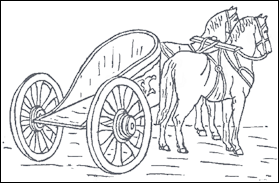
Carthaginian chariot”Among the charioteers of the steppes, the pattern was much the same,” Wilford wrote in the New York Times. Aryan-speaking charioteers, sweeping in from the north in about 1500 B.C., probably dealt the death-blow to the ancient Indus Valley civilization. But a few centuries later, by the time the Aryans compiled the Rig Veda, their collection of hymns and religious texts, the chariot had been transformed to a vehicle of ancient gods and heroes. [Source: John Noble Wilford, New York Times, February 22, 1994]
“Chariot technology, Dr. Muhly noted, seems to have left an imprint on Indo-European languages and could help solve the enduring puzzle of where they originated. All of the technical terms connected with wheels, spokes, chariots and horses are represented in the early Indo-European vocabulary, the common root of nearly all modern European languages as well as those of Iran and India.
In which case, Dr. Muhly said, chariotry may well have developed before the original Indo-European speakers scattered. And if chariotry came first in the steppes east of the Urals, that could be the long-sought homeland of Indo-European languages. Indeed, fast spoke-wheeled vehicles could have been used to begin the spread of their language not only to India but to Europe.
One reason Dr. Anthony has his "gut feeling" about the steppe origin of the chariot is that in this same period of widening mobility, harness cheekpieces like those from the Sintashta-Petrovka graves show up in archeological digs as far away as southeast Europe, possibly before 2000 B.C. The chariots of the steppes were getting around, possibly before anything like them in the Middle East.
The Horse, the Wheel, and Language
In a review of “The Horse, the Wheel, and Language” by David W. Anthony, Christine Kenneally wrote in New York Times, “Linguistic inheritance is a story of irreducible patterns and historical contingencies... Anthony argues that we speak English not just because our parents taught it to us but because wild horses used to roam the steppes of central Eurasia, because steppe-dwellers invented the spoked wheel and because poetry once had real power. [Source: Christine Kenneally, New York Times, March 2, 2008 ^*^]

Murong Painting ““English belongs to the very large Indo-European language family. All of the Germanic, Baltic, Slavic, Celtic, Latin, Hellenic, Iranian and Sanskrit languages (among other families) are Indo-European, which means that Lithuanian, Polish, English, Welsh, French, Greek, Kurdish and Punjabi, to name just a few, descend from the same ancient tongue. It is known as Proto-Indo-European, and it was spoken around 3500 B.C. Thanks to a careful comparison of the daughter languages (as linguists call them), thousands of Proto-Indo-European words have been reconstructed, including those for otter, wolf, lynx, bee, honey, cattle, sheep and horse. The way some words group together in Proto-Indo-European shows that its speakers believed in a male sky god, respected chiefs and appointed official warriors. One word for wheel sounded something like “roteh.” The word for axle? “Aks.” ^*^
Where Proto-Indo-European came from and who originally spoke it has been a mystery ever since Sir William Jones, a British judge and scholar in India, posited its existence in the late 18th century. As a result, Anthony writes, the question of its origins was “politicized almost from the beginning.” Numerous groups, ranging from the Nazis to adherents of the “goddess movement” (who saw the Indo-Europeans as bellicose invaders who upended a feminine utopia), have made self-interested claims about the Indo-European past. Anthony, an archaeologist at Hartwick College who has extensive field experience, makes the persuasive case that it originated in the steppes of what is now southern Ukraine and Russia, a landscape consisting mainly of endless grasslands and “huge, dramatic” sky. Anthony is not the first scholar to make the case that Proto-Indo-European came from this region, but given the immense array of evidence he presents, he may be the last one who has to. ^*^
“Anthony lays out crucial events that built up the economic and, later, military power of Proto-Indo-European speakers, increasing the reach and prestige of the language. It’s a linguistic version of the rich getting richer, with the result that more than three billion people around the world today speak a descendant of this mother tongue. Perhaps the most important moment came with the domestication of horses, first accomplished around 4,800 years ago, at least 2,000 years after cattle, sheep, pigs and goats had been domesticated in other parts of the world. Initially, horses were most likely tamed to serve as an easy source of meat, particularly in winter; it wasn’t until centuries later that they were ridden, and then eventually used to pull carts with solid wheels, turning the Proto- Indo-European speakers into mobile herders and the steppes into a conduit for themselves and their language. Later, they became skilled warriors whose spoked-wheel chariots sped them to battle and spread their language even farther. ^*^
“The impact of horses on the reach of language is particularly important to Anthony, and he conveys his excitement at working out whether ancient horses wore bits (and were therefore ridden by Proto-Indo-Europeans) by comparing their teeth to those of modern domesticated and wild horses. He muses on the “deep-rooted, intransigent traditions of opposition” that existed along the Ural River frontier, slowing the spread of herding and the cultural innovations that went with it. He also cites remarkable genetic analyses suggesting that although all the domesticated horses in the world may have come from many different wild mothers, they might all share a single father. ^*^
.jpg)
ancient Egyptian chariot
“Anthony also describes a world in which spoken poetry was the only medium, one that helped spread Proto-Indo-European through what he calls “elite recruitment.” It wasn’t enough for the newcomers to assume a dominant position: in order for their language to be picked up, they also had to offer the local population attractive opportunities to participate in their language culture — a process that continues today, incidentally, with the spread of English as a prestige language. “The Horse, the Wheel, and Language” brings together the work of historical linguists and archaeologists, researchers who have traditionally been suspicious of one another’s methods. Though parts of the book will be penetrable only by scholars, it lays out in intricate detail the complicated genealogy of history’s most successful language.
Book: “The Horse, the Wheel, and Language: How Bronze-Age Riders From the Eurasian Steppes Shaped the Modern World” by David W. Anthony ( Princeton University Press, 2008)
Chariots and Early Conquerors
The development of the chariot had a profound impact on history. The ancient Egyptians, Greeks, Persians, Indus Valley People and Chinese all had them. Chariots have been around much longer than many people think. They had been in use for almost 2,000 years when the sport of chariot racing was at its peak in ancient Rome.
According to Keegan, "Charioteers were the first great aggressors in human history."About 1700 BC, Semitic tribes known as the Hykos, invaded the Nile Valley, and mountain people infiltrated Mesopotamia. Both invaders had chariots. The Hykos introduced their technology to the ancient Egyptians. Around 1500 BC, Aryan charioteers from the steppes of northern Iran conquered India and later moved on to Greece. Around the same time the founders of the Shang Dynasty (the first Chinese ruling authority) arrived in China on chariots and set up the world's first state. " [Source: "History of Warfare" by John Keegan, Vintage Books]
Fighting chariots often accommodated two people — one rider and one archer. Early charioteers often swept down out of the mountains, encircled their flat-footed and unarmored foes, and picked them off from 100 or 200 yards away with arrows fired from sophisticated bows.
The ruthless, formidable and well organized Assyrians were perhaps the greatest charioteers of the ancient world. They dominated the ancient world from the 9th century to 7th century B.C. , when they were replaced by the Persians, a people that used chariots to create a huge empire that stretched from Greece to India.
Chariots ruled the world until foot soldiers in Alexander the Great's army learned to withstand chariot advances by aiming their weapons at the horses first: wearing arrow-proof armor and shields; and organizing themselves into tight chariot-proof ranks.
First Mounted Riders

rider in ancient Egypt
The earliest known representations of mounted riders are Egyptian bas-reliefs from 1350 B.C., showing bareback riders without stirrups sitting with their knees up as if they were sitting on a chair. They sat on the horse's rump instead of the back, apparently because the horses backs were not strong enough to support them.
Horse riding’s origins are uncertain and could date to at least 4,000 years ago, archaeologist Margarita Gleba of University College London told Science News. Victor Mair, a China and Central Asian expert at the University of Pennsylvania, suspects that horse riding began about 3,400 years ago in wetter regions to the north and west of the Tarim Basin in western China. [Source: Bruce Bower, Science News, May 30, 2014]
By the eight century B.C., the first mounted archers arrived on the plains north of he Black Sea and Caspian Sea and the Assyrians were riding stirrup-less horses in the position we are familiar with today. Assyrian bas-reliefs show riders side by side: one shooting an arrow, while the other holds his reins in what one scholar called "charioteering without the chariot."
In the 6th century B.C. the Scythians, a horse culture from the Eurasian steppe, introduced the cavalry, a method of warfare that would remain an effective for the next 2000 years.
The invention of stirrups around the A.D. 8th century had a profound impact on horseback riding and history. Stirrups enabled warriors to swiftly attack their enemies because they could stand up and shoot their bows while riding, effectively using their horses as platform with the stirrups firmly anchoring their feet in place. Stirrups appear to have originated in India and were introduced to the steppe via China. The Mongols and Turks used them, but the Huns did not. The introduction of stirrups to Europe, greatly improved riding there are made jousting possible.
Early People of the Steppe
The people who lived in Mongolia between 8,000 and 3,500 years ago were farmers not horsemen. Historian Adam Kessler told Time magazine: "From our knowledge of Genghis Khan and the Mongols, we had assumed tribes in this region spent most of their time on horseback. But archeology is beginning to show that from 6000 B.C. on, these were agrarian societies. [Source: Michael D. Lemonick, Time magazine, September 26, 1994]
Archaeologists working in Outer Mongolia and Inner Mongolia in China have uncovered the remains of more than 100 walled cities of settled people dating back to 3rd millennium B.C. and found extraordinarily beautiful artifacts such as stone altars and jade dragons. Scattered around Outer Mongolia are burial stones organized in squares and circles. Some cover slab-lined tombs and are thought to date as far back as to 2000 B.C.
Around 1500 B.C., Mongolia became colder and drier — a climate more conducive to grasslands than crops — prompting a shift from a crop-based to livestock-centered society. Cattle was raised in areas where pastures were rich. Sheep were raised in areas where the pastures were sparser.
First Horsemen of the Steppe
The forefathers of the Mongols, Turks, Huns, and Scythians were horsemen, shepherds and hunters who used bows, arrows and javelins. These people ate horsemeat and mutton and hunted snow leopards, geese, hares, wolves, lynx and reindeer.
These first steppe horsemen are believed to have evolved around 1000 B.C. when the climate became colder and herders could no longer raise their animals in one place and were required to move them from to place. Exactly how these early horsemen evolved and when they first began riding is not known but is hypothesized that horses were first utilized on the steppe was to herd other animals
In the centuries that preceded and followed the birth of Christ, the Central Asian steppes were inhabited by dozens of semi-nomadic peoples, including the Altais, Scythians and Pazyryks. The most well known of these groups, the Scythians, were contemporaries of the ancient Greeks.
See Scythians
Deer Stone People
Deer stones are ancient monoliths with images of deers and other animals carved on them. They were made between 1000 and 700 B.C., around the time that people in the steppe were becoming nomadic herdsmen. Many have images of deers. Some have images of the sun and the moon. Almost always face east towards the rising sun.
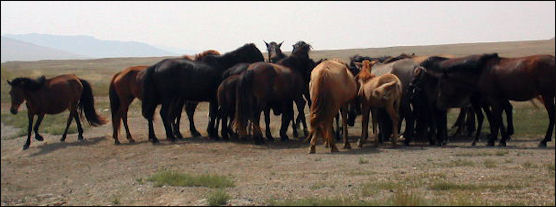
Mongol horse herd
There are 450 deer stones scattered across northern Mongolia, particularly in Bulgan, Khovd and Ulaangom provinces, and in southern Siberia. The tallest are about five meters tall. They have been dated based on weapons and tools some of the figures carry. Some scholars think they are be memorials, usually associated with burial mounds and horse graves. William W. Fitzhugh, directors of Smithsonian’s Arctic Studies Center told the Washington Post, he thinks “they’re symbolic of powerful chiefs and warriors.”
The relationship between the Deer Stone people and other people of the steppes is not known. The lived at around the same time as the early Scythians but were not Scythians. The Scythians. also were fond of deer images but their deers were quite different that the ones seen on deer stones.
Mongolian Studies specialist Christopher Atwood of Indiana University told the Washington Post, “Most probably what you had was an attractive and charismatic package of nomadic pastrorlism and a dynamic horse culture. A small elite [of deer stone people] conquers the Scythains and then lose their language and subsequently their culture.”
See Separate Article DEER STONES factsanddetails.com
Images on Deer Stones
One of the tallest and most complete deer stones is near the place called of Ushkin Uver, near the Mongolian town of Muron, about 300 kilometers south of Irkutsk, Russia. It is one of the tallest deer stones and the only one with a full face. The face is three dimensional. Below it are outlines of a deer. It is thought the deer represents a tattoo of the warrior immortalized by the deer stone.
It is not clear what kind of deer is represented in deer stones. Many scholars think they are reindeer. A small group of reindeer herders does live in the area where main deer stones are found. University of Oregon Art historian Esther Jacobson-Tepfer told the Washington Post she thinks they are Mongolian forest elk. “My theory is that the are a deliberate stylization of joining deer and birds, relating both to the tree of life of life and transformational souls.”

Deer stones
Image Sources: Wikimedia Commons, The Louvre, The British Museum
Text Sources: New York Times, Washington Post, Los Angeles Times, Times of London, Yomiuri Shimbun, The Guardian, National Geographic, The New Yorker, Time, Newsweek, Reuters, AP, Lonely Planet Guides, Compton’s Encyclopedia and various books and other publications.
Last updated February 2022

